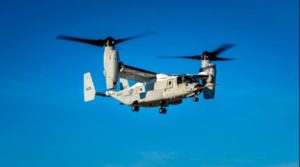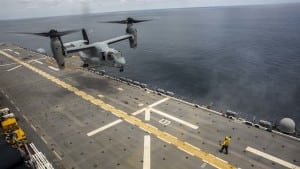Bell [TXT]/Boeing [BA] V-22s Osprey tiltrotor aircraft across the Navy, Marine Corps and Air Force are getting time limits and some aircraft are being grounded due to an engine clutch issue, pending replacement parts and a longer term fix.
The V-22 Osprey Joint Program Office (JPO) (PMA-275) recommended time limits to the three services that use the aircraft to minimize damage, which they have enacted.

The problem is tied to the input quill assembly, a part of the proprotor gearbox that houses the aircraft clutch. The time limit recommendations followed an ongoing engineering analysis of a progressive increase in “hard clutch engagement events,” in V-22s.
In a hard clutch engagement, the engine-driven clutch releases from the rotor system and suddenly reengages, which sends a pulse through the drive train that can possibly cause damage, the program office explained in a statement.
“In order to ensure the continued safety of the aircrew, the services took decisive action to implement the bulletin,” the office added.
The Navy, Marine Corps and Air Force Special Operations Command (AFSOC) issued the time limit in line with the JPO recommendation via fleet bulletin, effective Feb. 3.
The Navy uses the CMV-22 variant, the Marine Corps uses the MV-22, and the Air Force flies the CV-22.
The bulletin says aircraft with input quill assemblies above an undisclosed predetermined flight-hour threshold are required to be grounded until the component is replaced.
Once the assembly is replaced, each individual aircraft will return to flight status.
DoD said it will not disclose the specific flight-hour threshold or number of aircraft affected by their assemblies reaching that flight-hour limit “due to operational security concerns.”
However, The JPO is exploring 24 initiatives to aid in short, mid and long-term solutions to the clutch problem, split among four lines of effort: analyze, identify, mitigate and eliminate. The initiatives include data mining, laboratory and flight testing, and hardware redesign.
The JPO said these efforts already helped it identify and implement the input quill assembly time limit.

“We will use relevant findings to continually improve the safety of the V-22,” the office added.
The Joint Program Office underscored the three services previously implemented training to mitigate problems, including supplying interim flight guidance to the fleet aimed at minimizing exposure to a hard clutch engagement and adding modified hard clutch engagement scenarios to simulator training.
This comes after the Air Force has previously dealt with these clutch slippage issues, which date back over a decade.
In September, AFSOC lifted a two and a half week grounding of its CV-22 fleet while it continued investigating the root cause of the clutch slippage. That followed a recent sprag clutch incident when a CV-22 in an Arctic exercise in Norway had to make an emergency landing (Defense Daily, Sept. 7).
At the time, AFSOC commander Air Force Lt. Gen. James Slife said the V-22 has experienced 15 incidents over the last dozen years, four with AFSOC and 11 with the Marines’ MV-22s. None have been reported with the Navy’s CMV-22B version.
“We’ve all understood that this is a mechanical problem. What’s eluded us is the root cause. Why is the clutch slipping in the first place? At AFSOC, we’ve had two of these events in the last couple of months now. My standdown was an opportunity for us to bring some attention to this in the engineering enterprise,” Slife said.

Slife also said almost all of the events occurred with gearboxes with the same amount of flight time, which allowed AFSOC to put some restrictions in place to limit the chance it occurs again while the investigation continued.
“We were able to hammer out the specific operational restrictions we were going to put in place. It’s things like how we manage our power settings during take-off, how frequently we do vertical take-offs, versus short take-offs. If you’ve got a runway available, use the runway–those types of things. I feel pretty comfortable that appropriate mitigation measures are in place,” he added.
The joint program office did not disclose how long the unspecified number of V-22s are expected to be grounded for or how payment for the replacements and fixes is being allocated by time of publication.